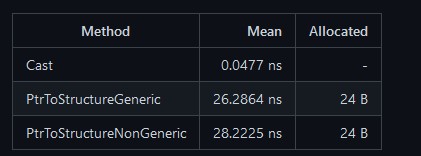在 dotnet 里面,拿到一个指针,可以有多个不同的方法转换为结构体,本文将来告诉大家这几个方法的性能的差别
特别感谢性能优化狂魔 Stephen Toub 大佬的指导
在 WPF 框架开发中,有小伙伴 ThomasGoulet73 问 Stephen Toub 大佬关于从指针转换为结构体的性能差别,请看 https://github.com/dotnet/wpf/pull/4917#discussion_r690587610
此时 Stephen Toub 大佬给出的性能测试如下

通过 Cast 转换的性能是最佳的,但是需要用上不安全代码,使用的时候也有很多注意的事项。而采用 Marshal 的 PtrToStructure 有两个重载的方法,一个是泛型的,一个是非泛型的,测试代码如下
using BenchmarkDotNet.Attributes;using BenchmarkDotNet.Running;using System;using System.Runtime.InteropServices;
[MemoryDiagnoser]public class Program{ public static void Main(string[] args) => BenchmarkSwitcher.FromAssembly(typeof(Program).Assembly).Run(args);
private IntPtr _ptr;
[GlobalSetup] public unsafe void Setup() => _ptr = Marshal.AllocHGlobal(sizeof(MyPoint));
[GlobalCleanup] public void Cleanup() => Marshal.FreeHGlobal(_ptr);
[Benchmark] public unsafe MyPoint Cast() => *(MyPoint*)_ptr; // 0.0477ns
[Benchmark] public MyPoint PtrToStructureGeneric() => Marshal.PtrToStructure<MyPoint>(_ptr); // 26.2864ns
[Benchmark] public MyPoint PtrToStructureNonGeneric() => (MyPoint)Marshal.PtrToStructure(_ptr, typeof(MyPoint)); // 28.2225ns}
[StructLayout(LayoutKind.Sequential)]public struct MyPoint{ public int X; public int Y;}在 Stephen Toub 大佬的建议是,虽然 Cast 方法,通过不安全代码指针转换的方法的性能足够好,如上面测试 只需 0.0477 纳秒,但是只有在类型是 blittable(可直接复制到本机结构中的类型)的时候才适合用强转的方式。否则还是需要使用 Marshal 的方法处理封送
一个有趣的事情是 PtrToStructure 的泛型的和非泛型的方法实现基本一致,如下面代码
public static object? PtrToStructure(IntPtr ptr, Type structureType) { // Ignore some code ... object structure = Activator.CreateInstance(structureType, nonPublic: true)!; PtrToStructureHelper(ptr, structure, allowValueClasses: true); return structure; }
public static T? PtrToStructure<T>(IntPtr ptr) { // Ignore some code ... object structure = Activator.CreateInstance(structureType, nonPublic: true)!; PtrToStructureHelper(ptr, structure, allowValueClasses: true); return (T)structure; }可以看到泛型的版本其实就是强转一下返回而已

本作品采用 知识共享署名-非商业性使用-相同方式共享 4.0 国际许可协议 进行许可。 欢迎转载、使用、重新发布,但务必保留文章署名 林德熙 (包含链接: https://blog.lindexi.com ),不得用于商业目的,基于本文修改后的作品务必以相同的许可发布。如有任何疑问,请与我 联系。